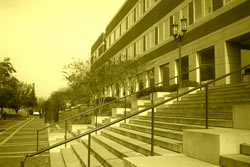|
|||||||
|
|
|
Home |

|
March 21st: Visual and Intercultural CommunicationAnnouncements/Overview
Midterm Review The midterm is closed in Moodle, but I have a copy up on the big screen. Let's go over the questions. Chapter 12 Highlights: This chapter isn't the most effective way to discuss "culture," but it does provide some points for us to take up. I normally prefer to discuss culture by asking students to consider their ideas related to social situations and then think about times when things got messy or confusing in intercultural settings. I'm not a proponent of essentializing or making sweeping generalizations about culture, but patterns do emerge, so we ought to be aware of them. Just recognize the limitations our generalizations may have.
Visual Culture Being the cultural, social creatures that we are, much of our visual world is shaped by our experiences. I know some don't like to hear this, but we are rarely able to free ourselves from the cultures into which we're born. Even the choices you think you have are simply choices on a cultural menu, a group that's socially constructed. A former professor of mine told our class that people hate being told that their culture is based on societal constructions and has no connection to absolute truth: (paraphrased from memory) "cultural pride deals in absolute value or worth—they don’t want to hear it’s contextual" (Thomas Van, 9/16/2003). But there's good news about cultural constructions and perceptions. Because members of a culture share commons backgrounds and ideologies, designers can tap into that shared knowledge. You might not be conscious of it, but, when you use idioms, refer to Seinfeld episodes, and use language, you're engaging in socially constructive activities. Some additional things to discuss about culture and visuals are below (not in the book):
The Wonderful World of Machines We're going to start getting into Degani's Taming Hal: Designing Interfaces Beyond 2001. This will probably start after the break, so be thinking about abstractions and there relation to interfaces and diagrams of interfaces, systems, phenomena, etc. Also, consider the fact that some abstractions of interfaces help or hurt user understanding. Remember this abstraction of a system (often called a diagram)? Hal: Chapters 1 & 2 I would like you to think back to an earlier time when you first learned how to ride an elevator. It might be difficult to recall, but I want you to try to see if you remember how you learned that you could walk into a closet-sized room with Star Trek doors, push a button, and expect to go up...or down. If this doesn't get your mind going, list or describe elevator etiquette or procedures you adhere to and expect of others. Logon to Moodle and respond to the "Elevator Prompt." Below (the strikethrough text) was the original plan, but I want to give you a chance to have more participation credit, so let's attempt to do this activity as a larger class. Review all the questions for the next 10 minutes and be ready to say something about them.
User Doc #2 User Testing This week you'll have a more in-depth user test to accompany your more in-depth User Doc #2. I know all of you will work hard to help your fellow classmates by being as objective as possible. The first change, though, will be that I want you all to come up with three personas for the instrument you'll document. Also, ideally I would like for you to have something a user could test in class, but that's not a requirement. Your fellow classmates can still give you feeback on your documents. I also want you to include the following in what you'll turn in to me on 3/28:
Note: measurable goals mean that users can not only accomplish tasks but they can accomplish them within or under quantifiable standards. For instance, a vague, immeasurable goal would be, "create a user friendly set of instructions"; whereas, a measurable (operationalized) goal would be, "create a document that gets users to setup the instrument within five minutes with no more than two lookups in the help menu." Additionally, a Likert scale could be an attempt to quantify qualitative data: On a scale of 1 to 5 (5 being the highest), please rate your satisfaction with the product." But let's be critical of our Likert Scales and quantifying subject data in general. User Test Setup I decided not to choose who you should get to user test your document. Please have at least two classmates test your document. I'll be coming around to note who has their drafts. Make sure you give the users the post-test questions. Before We Go... Your Individual User Doc #2 is due next week. Keep reading Degani's Taming Hal: Designing Interfaces beyond 2001--Ch. 3 and 4 are supposed to be read for next week. Also, don't forget to bring your books with you next week. We'll start planning for User Doc #3 next week.
..
|
||||||||||||||||||||||||||||||||||||||||||||
|
|
|||||||||||||||||||||||||||||||||||||||||||||
| © UNC Charlotte Copyright | Privacy Statement | Page Maintained By: Aaron A. Toscano |
